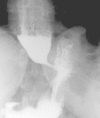Robotic telesurgery for achalasia
- PMID: 25484935
- PMCID: PMC4247422
- DOI: 10.1007/s11701-006-0001-y
Robotic telesurgery for achalasia
Abstract
The craft of surgery has always relied on the use of instruments. Innovations in surgery have paralleled innovations in instrumentation. Advances in surgical instrumentation continue today and have enabled huge strides in surgical procedures and outcomes during this generation. Computers and related technology are now changing the interface between the surgeon and the patient, and are poised to improve patient outcomes by enhancing the surgeon's skills and training. The application of computer enhanced telemanipulators, or "robots", may specifically enhance operations, for example Heller myotomy, that require good visualization and precise careful dissection of delicate structures. This review covers the pathophysiology of achalasia and its history of medical and surgical treatment, leading to modern robotic telesurgical approaches. Improvements in outcome from medical to standard surgical to robotic telesurgical approaches are discussed. Current operative technique for robotic telesurgical treatment of achalasia is described and the authors conclude with a glimpse of where, in the future, current research endeavors will lead us in the treatment of achalasia.
Keywords: Achalasia; Computer assisted; Heller myotomy; Robotic assistance.
Figures






References
-
- Pasricha PJ (2006) http://patients.uptodate.com/topic.asp? file=digestiv/4384 September 26 2006
-
- Heller E. Extramukose cardioplatik beim chronishcen cardiospasmus mit dilation of the oesphagus. Mitt Grenz Med Chir. 1914;27:141–149.
Publication types
LinkOut - more resources
Full Text Sources

